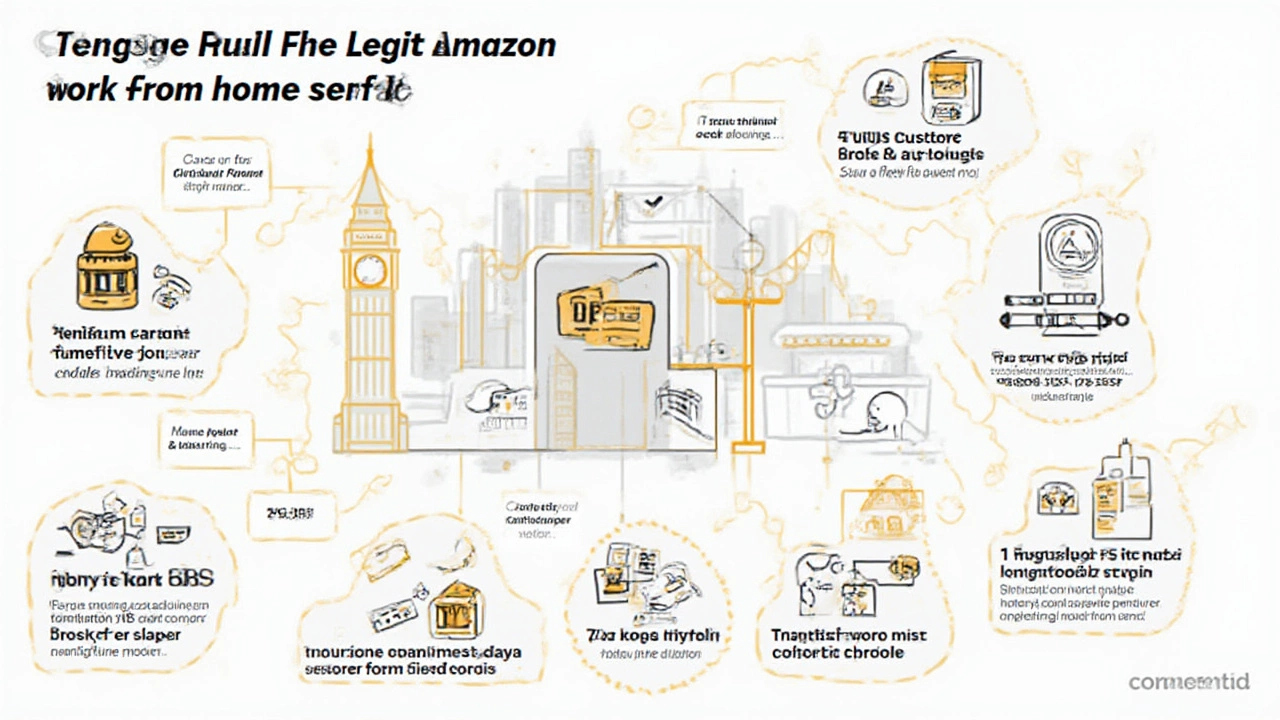Picture this: you wake up, grab a coffee, flip open your laptop, and clock in for your Amazon shift—all while wearing pajamas. If you thought remote jobs were just a pandemic thing, you better hold onto that mug. Amazon, a behemoth with over 1.5 million workers globally, has been fueling the remote revolution for years. But here's the catch—finding a legit Amazon work-from-home role isn't as easy as it sounds. Lots of folks are scrolling job boards, hoping they'll score a real paycheck from the comfort of home. So, does Amazon really pay people to work from home? Or is it just smoke and mirrors? Let's tear down the filters and see what's actually happening behind those virtual doors.
Types of Remote Jobs Amazon Offers
If the first thing you think of when someone mentions Amazon is a warehouse packed with cardboard boxes, you're missing half the picture. Amazon's "Virtual Locations" division is a goldmine of remote gigs. We're talking customer service reps helping someone reset a password, HR pros onboarding new hires in faraway cities, tech wizards debugging Alexa skills, and even virtual sales teams. There's a surprisingly big variety, and these roles go way beyond basics like data entry.
Amazon classifies most remote jobs as “Virtual” or “Remote.” These are real employee roles, not gig gigs—think W2 jobs with benefits, paid time off, and even stock options for full-timers. On any given week, Amazon might post hundreds of remote job listings, especially during high-traffic times like Prime Day or the holidays. It's a moving target, so set up job alerts if you're eyeing something specific.
Some common remote jobs at Amazon include:
- Customer Service Associate
- Technical Support Associate
- Human Resources
- Solutions Architect
- Pharmacist (for their online pharmacy unit!)
- Virtual Recruiter
- Content Reviewer
- Project Manager
- Data Analyst
- Marketing Manager
What about side gigs or part-time stuff? Amazon runs a separate "Mechanical Turk" platform, but that's not a regular employee job—it's more piecemeal work, perfect for some extra cash. Same goes for Flex, where you deliver packages using your own car, but that’s totally different from these official employee roles.
What You Need to Get Hired Remotely at Amazon
Let’s set one thing straight—Amazon is picky. The jobs get tons of applicants, partly because remote work is so in demand. Here’s what they’re usually looking for:
- Reliable internet and computer setup. You’ll need a fast, stable connection and often a hardwired ethernet line. Some positions even send you Amazon equipment, like a headset and monitor, but you almost always need your own computer to start.
- Experience and skills that match the role. Entry-level remote jobs want good communication. Tech roles? They’ll test you on cloud, code, or other hard skills. If you’re angling for HR or Marketing, you need professional writing and digital communication chops.
- Self-motivation and focus. Work-from-home roles mean you’ll be measured on output. Expect Amazon’s famously intense culture and metrics, even from your kitchen table.
- Sometimes, you must live in a specific state or country. Not all remote jobs are wide open—some depend on tax laws or customer needs. Always read the fine print.
- If you’re bilingual or have industry certificates (like AWS Cloud Practitioner), you’ll jump ahead of the pack.
Once you spot a role you like, prepare for Amazon’s unique hiring process. They love “behavioral interviews,” which often start with a screening call, then ask about a time you solved a problem, showed leadership, or juggled multiple deadlines. It’s smart to use the STAR method (Situation, Task, Action, Result) when you answer, and keep it tight—think specific, not rambling stories. Amazon hires people who fit their quirky “Leadership Principles,” so sprinkle those in naturally.

How Much Does Amazon Pay for Work-from-Home Jobs?
This question is the million-dollar one—sometimes literally. Amazon remote jobs span a huge pay range, depending on experience and field. A virtual customer service associate might start at $16–$21 an hour, often with paid training. More technical roles, like software developers or product managers, can hit six-figure salaries. In fact, according to Amazon’s 2024 jobs report, median starting pay for remote tech jobs is $76,000 per year, while non-tech, customer-facing roles average $39,000–$48,000 annually.
| Role | Average Pay (USD) | Remote? |
|---|---|---|
| Customer Service Rep | $38,000 / year | Yes |
| Software Developer | $120,000 / year | Yes |
| Human Resources | $60,000 / year | Yes |
| Virtual Recruiter | $55,000 / year | Yes |
| Solutions Architect | $140,000 / year | Yes |
| Mechanical Turk | $2–$5 / task | Yes |
Another key thing? If you live in an area with a higher cost of living, some remote jobs pay more. Some jobs are hourly, others are salaried. Nearly every employee role includes health coverage, 401(k) match, and starts accruing time off. For part-timers, the benefits package is still better than lots of places—think dental, vision, even tuition help.
If you’re aiming for better pay, focus your search on tech roles, project management, or anything related to cloud computing. Those always come with bigger paychecks thanks to Amazon’s relentless push into cloud and AI.
Where to Find Legit Amazon Work-from-Home Jobs—And How to Avoid Scams
The minute you Google “Amazon work from home,” you’ll see enough shady promises to last a lifetime. Let’s set the record straight: Amazon doesn’t charge you to apply, and every remote employee job offer comes with a @amazon.com email and official onboarding.
So, where do you find the real deal?
- Amazon Jobs Portal (https://www.amazon.jobs): Always start here. Type “remote” or “virtual” in the search bar and filter by your country or state.
- LinkedIn: Amazon posts tons of jobs, but double-check that you’re directed to apply through the official portal.
- Glassdoor and Indeed: Great for reviews and average salaries, but always apply on the real Amazon site.
How can you spot scam jobs pretending to be Amazon?
- Anyone asking for upfront fees or banking info before you get a signed offer—run the other way.
- The interview emails don’t use the standard @amazon.com domain.
- They want your Social Security number or personal details before interviews begin.
- The offer sounds way too good for your skills or location.
Stitch this advice to your screen: Amazon will never hire through Telegram, WhatsApp, or any channel besides their official jobs portal or secured partner recruiters. If you’re ever unsure, copy the recruiter’s message and email it to Amazon’s fraud department. Thousands lose money to work-from-home scams every month. Stay sharp, and you’ll be fine.

Real-Life Tips to Succeed in Amazon Remote Roles
Anyone who thinks working from home means slacking off hasn’t tried meeting Amazon’s weekly quotas. Expect lots of structure. Schedules are often assigned, team chats run all day, and output gets measured—no hiding under the duvet. Here's how you thrive (and keep your sanity):
- Make a daily workspace, even a corner. Think great lighting, comfy chair, and no laundry piles in the background.
- Invest in noise-canceling headphones and an extra monitor. Shows you mean business in video calls and saves your neck (literally).
- Take breaks. Amazon’s pace is high, but walking outside or stretching every hour keeps the stress in check.
- If you're juggling kids or other responsibilities, set clear work/life boundaries—even hang a 'Do Not Disturb' sign during meetings.
- Use Amazon's free training and upskilling tools. They offer workshops and certifications (like AWS Cloud) that can turn a temp gig into a long-term career.
- Network with coworkers through Slack or Teams; you’ll discover internal job postings before anyone on the outside does.
- Don’t be afraid to ask for help. Supervisors expect questions, especially in the first few months.
Remember, Amazon values planners and problem-solvers, not clock-watchers. Show you can handle tasks without hand-holding, and your career could skyrocket fast—from part-time rep to full-on manager in a couple years.
The bottom line? Amazon really does pay people to work from home, and the options keep growing. But it’s not free money or a hands-off gig. It’s demanding, fast-paced, highly measurable work with real pay, real benefits—and yes, a real sense of accomplishment, especially if you can balance your couch laptop with a goals spreadsheet. Check the official portals, polish up your resume, and who knows—the next time you order a package, you could be getting paid to help make it happen, right from your living room.
